Varieties and varieties of beans: horse (garden), decorative, large-fruited vegetables, fodder
Legumes are the largest family of dicotyledonous flowering plants. In the tropics and subtropics, leguminous trees and shrubs grow, in latitudes with a temperate climate, these are herbaceous plants.
The list of common food crops includes peas, beans, beans, lentils, soybeans, chickpeas. For animal feed, forage beans, clover, and alfalfa are grown. In our article, we will focus on beans.
The content of the article
What are the beans
By the appearance of the fruit of the beans not to be confused with beans and peas: flattened shape, varied color.
They are not inferior in composition beans, but lose to her in taste and culinary qualities.
100 g of beans contain:
- proteins - 26 g (35% of the daily value);
- fats - 1.53 g (2% of the daily value);
- carbohydrates - 58 g (19% of the daily value);
- water - 11 g;
- ash - 3 g.
The calorie content of 100 g of the product is 341 kcal. The combination of vitamins - groups B, A, PP, C, E - and trace elements - sodium, phosphorus, potassium, iron, zinc - make the product irreplaceable in dietary and baby food.
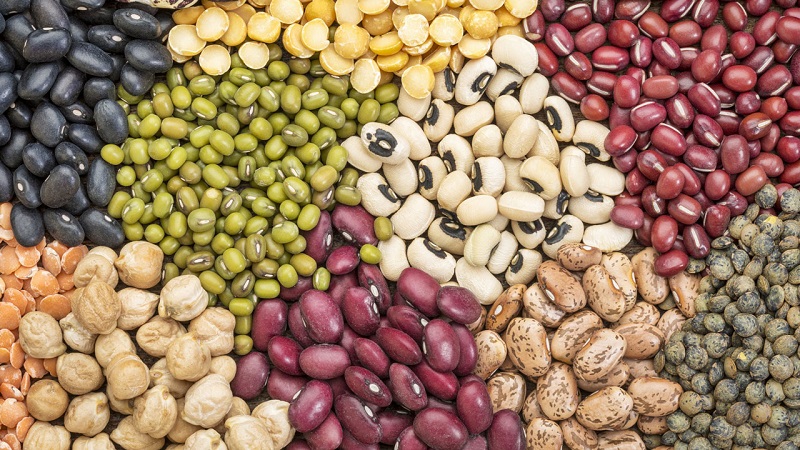
Why beans are good for humans:
- neutralize preservatives, since the composition contains molybdenum;
- daily consumption of 100-150 g of beans lowers cholesterol;
- remove heavy metals and radionuclides, which is important for everyone;
- B vitamins improve brain function;
- vitamins PP, K, C soothe and relieve stress.
The vegetable causes flatulence. It should be used with caution by people with gastrointestinal problems. Undercooked and uncooked beans, especially black beans, cause severe food poisoning.
Important! Beans do not accumulate nitrates and are considered an environmentally friendly product.
For economic purposes, plants are divided into vegetable (food, garden) and fodder.
Horse or garden beans

Horse beans - what is this plant? Garden bean (Vicia faba), equine or Russian is a species of annual herbaceous plants of the genus Vicia of the legume family. It reaches a height of 20 cm to 150 cm. The powerful taproot goes 90-140 cm underground. The tetrahedral stem is densely covered with bluish-green leaves. White or pink flowers with black spots on the wings have a pleasant sweet scent that attracts pollinating insects.
Reference. The history of cultivation dates back to the biblical times of the reign of King Solomon.
Popular varieties: Russian black, Velena.
Garden beans Russian black
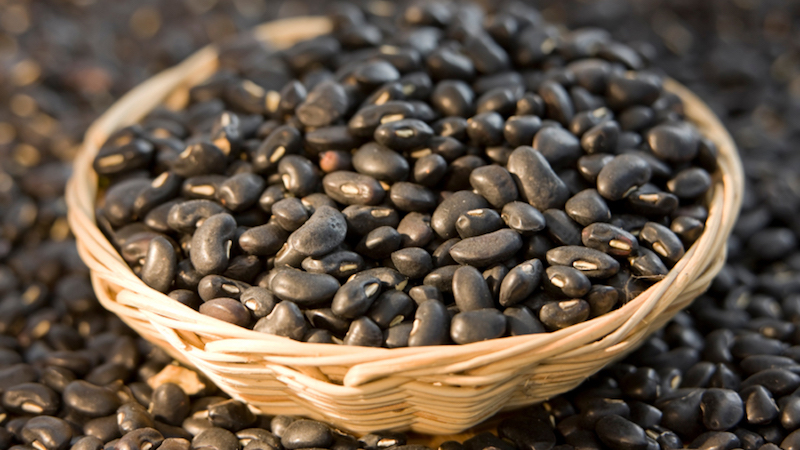
The variety was bred by the All-Russian Research Institute of Selection and Seed Production of Vegetable Crops. It has been grown throughout the country since 1943.
A plant up to 60 cm high with a branched stem. The flowers are white with purple veins on the sail and dark spots on the wings.
7-15 elongated pods 7-8 cm long are formed on the plant. 2-3 dark purple fruits ripen inside.
Russian blacks are a medium early variety. From planting seeds to full maturity, 70-80 days pass, to technical ripeness - 60-65 days. The crop yield is average - 0.5 kg per 1 sq. m.
The variety is unpretentious in care.
It is interesting:
A selection of the best recipes for canned green beans.
Garden bean Velena
Bred by the All-Russian Research Institute of Selection and Seed Production of Vegetable Crops. It has been grown since 1993.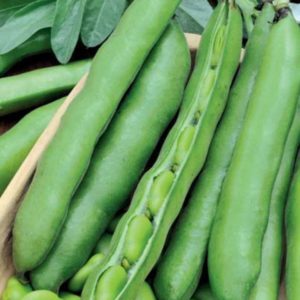
Velena has an erect weakly branched stem up to 1 m high, complex leaves of a dark green color, large white flowers with black spots on the wings.
Sugar pod, without parchment layer, up to 12 cm long, with 3-4 fruits inside. The beans are angular, pale yellow.
Vilena belongs to the mid-early varieties - 85-90 days pass from germination to technical ripeness. The yield is high - 1.5 kg per 1 sq. m.
The variety is susceptible to ascochitis.
Reference. The best seeds are those that have undergone all the necessary processing by the manufacturer, even if the varieties are resistant to diseases and pests.
Decorative
The legume family includes ornamental beans.
These are bush-shaped annuals or climbing vines. Blooming and healthy beauty came to Europe in the 15th century from South and Central America and became incredibly popular.
Ornamental beans are both a garden decoration, a low-calorie tasty fruit, and a natural nitrogen fertilizer for the soil. Planted next to potatoes, they increase yields by up to 50% and repel the Colorado potato beetle.
Reference. The main enemy of decorative beans is freezing.
Planting decorative curly beans and caring for them are similar to the agricultural technology of the beans we are used to.
Ornamental purple beans, or hyacinth beans
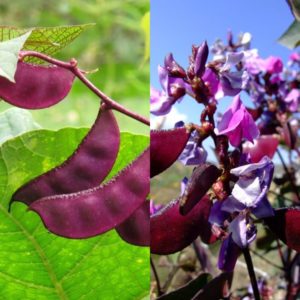
Inedible variety. Liana grows up to 4 m long.
When 4-5 leaves appear in a young plant, pinch the top, which causes rapid growth of shoots.
Purple beans - the owner of a variety of leaves (green, purple, reddish) and the same inflorescences (white, pink, raspberry with a pleasant sweet aroma).
Pods 10-15 cm in size are green, dark purple in color.
Fiery red multiflorous beans, or Turkish beans
The plant is unpretentious in growing. It looks impressive: it grows up to 4 m in length, blooms with bright red small flowers, foliage is dark green in saturated color. The fruits are edible, light purple in color with black dots.
Turkish beans (see photo) bloom from June to September. In their young form they are eaten as asparagus beans, in ripe - as beans. Before use, the fruits are boiled well.
Blauchild
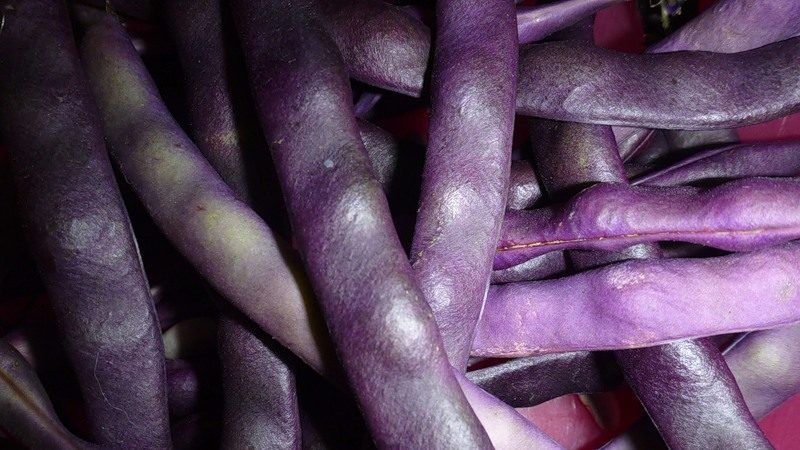
Everything - and leaves, flowers, and pods - has a dark purple hue.
The variety is late, it is safer to grow it through seedlings. Blooms early. On one plant during the season there are both flowers and fruits.
Blauhilda is an asparagus type of beans, pods 15-20 cm long when cooked change color to green. Fruits in pods are beige, when cooked they become oily in taste.
The liana of this variety is heavy, up to 4 m long, so it needs a solid support.
Purple lady
Medium early curly asparagus variety. Liana is low - up to 1.5 m. Flowers are large purple. Pods of the same color, 15-20 cm long, are ready to eat 50-55 days after germination.
The variety bears fruit abundantly and has a high taste.
Vegetable
Beans are undeservedly forgotten today. In terms of protein content, they compete with meat and can replace it on fasting or fasting days.
Modern varieties have large fruits and are grown in different climatic zones.
White large-fruited
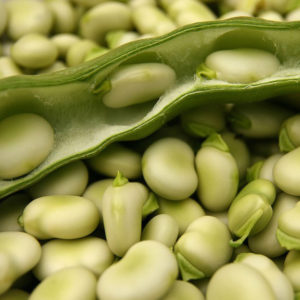
The variety of the trade brand "Aelita" high-yielding, mid-season cold-resistant... The period from germination to seed ripening lasts 90-110 days, to the consumer ripeness of young beans - 40-50 days.
A bushy plant up to 90 cm high forms 10-15 straight pods 20-25 cm long, which contain 6-7 large fruits. At milky ripeness they are light green, and ripe ones are white.
Seeds are sown in open ground, soaked before swelling. The seeding depth is 5-8 cm. At the beginning of flowering, the plants are pinched to accelerate ripening.
Windsor
Medium late cold-resistant variety, bred by English breeders more than 200 years ago, is suitable for growing in the North-West and Central regions of Russia.
The variety is divided into Windsor whites and Windsor greens:
- in Windsor whites, the growing season lasts 120 days, the fruits are white;
- Windsor Greens have a growing season of 130 days, beans are green.
Branched stem reaches 1 m. Flowers are white or pink with spots. Large pods crack when ripe. Inside there are two large beans, rarely three.
The yield of the variety is high - from 1.5 kg per 1 sq. m.
Reference. Windsor varieties are superior to other varieties in terms of vitamins A and C.
Belarusian
The selection variety of the All-Russian Research Institute of Selection and Seed Production of Vegetable Crops has been grown since 1950.
Description of Belarusian beans:
- weakly branched plant, 60-90 cm high;
- flowers, white with brown streaks, form a pod 8-12 cm long with 3-4 beans inside, which cracks when ripe;
- fruits are oval dark green;
- the growing season is 90-110 days;
- yield - 0.5 kg per 1 sq. m.
The Belorusskie variety has a high protein content.
Fodder varieties
Broad beans are an ancient culture, but their cultivation areas are small in Russia.
The biological characteristics of forage beans include:
- the minimum temperature for seed germination is -3 ... -4 ° С;
- undemanding to heat during the growing season - + 18 ... + 20 ° С is enough;
- frost resistance - can withstand temperature drops down to -5 ° С.
The grains contain up to 30% vegetable protein.
Siberian
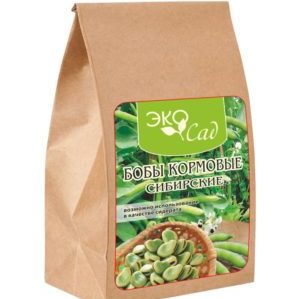
The variety "Siberian Federal Scientific Center of Agrobiotechnology RAS" was approved for cultivation in 2007. Recommended for cultivation in the West Siberian region.
The growing season for silage is 55 days, for grain - 90-100 days.
The plant is medium-sized, the pods do not crack when ripe.
Vegetable protein content - 29%, crude protein - 17%.
The average grain yield is 35 c / ha.
Streletsky
A new variety of legumes with a yield of up to 70 c / ha and a protein content of up to 33%.
Resistant to frosts down to -3 ° C, droughts and diseases. The growing season is 90-100 days. Plants do not lie on the vine, the fruits do not fall off.
Conclusion
The benefits and beauty of the beans are great. Due to their high protein content, they are a complete substitute for meat. Many species are used to decorate plots, as animal feed. And the variety of varieties allows you to grow a crop in almost any climatic zone of the country.